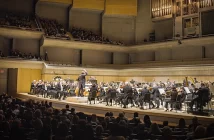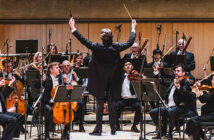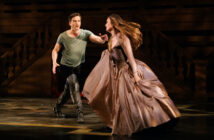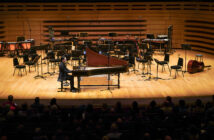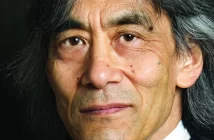This year we decided to make a stop in Charlottesville, Virginia, a favourite place we hadn’t visited in too many years. This charming, lively, petite (pop: 40,000) mountain town is home to the University of Virginia where we fondly recalled once having inspected the tiny room inhabited by Edgar Allen Poe during his short tenure as a student here. The literary stature of Poe notwithstanding, Charlottesville is most famous for Monticello, the home of Thomas Jefferson, one of the founding fathers and the third president of the United States.
Castleton Farms Home to Castleton Festival As we plotted our route from Charlottesville to the Eastern Townships of Quebec, we decided it would be unconscionable to pass within a few miles of Lorin Maazel’s new Castleton Festival without seeing what all the excitement was about; with Maazel in mind, we set out along the back roads of western Virginia.
As we plotted our route from Charlottesville to the Eastern Townships of Quebec, we decided it would be unconscionable to pass within a few miles of Lorin Maazel’s new Castleton Festival without seeing what all the excitement was about; with Maazel in mind, we set out along the back roads of western Virginia.
The town of Castleton turned out to be little more than a general store. Mostly, we were greeted by lush green rolling hills and farmland, with just enough signage to remind locals where they are and to give visitors the feeling that one wrong turn could get them hopelessly lost.
There were few signs directing one to the Castleton Festival. Upon arrival at what we took to be the festival headquarters, our first impression was that everyone had either gone for a walk in the woods or was attending to farm chores. We walked through the small lobby into a tiny jewel of a theatre. We could hardly believe that La Bohème had been performed here the day before. The pit could scarcely hold more than a dozen players and the house appeared to have no more than 100 seats.
Back outside, looking off the deck, we could see well-tended gardens and a pond in the distance. Further along the deck we could see a fair number of people in the cafeteria attached to the theatre. It was lunchtime and dozens of young people were either enjoying a meal or working away on laptops – some doing both at once. All in all, it was a beautiful estate, a glorious place for work and leisure.
We continued our explorations, looking now for someone in administration. Across the road from the theatre building was a small barn. Lots of out-of-state license plates in the driveway indicated visitors, but this was clearly a working farm. There were pigs in pens, some cattle, and a zebra – or was it a “zonkey?” Someone with a sense of humour had put up a sign describing an even more unusual animal on the premises – a zonkey – an exotic blend of donkey and zebra. There was even a picture to aid in recognition.
Next door, as we stepped out of the car, one of two young women walking towards us stopped to introduce herself as “one of the Maazel children” and kindly offered to find someone to help us. She disappeared through a hedge and emerged a few minutes later with a strikingly attractive woman, who introduced herself as Dietlinde Maazel. I knew that Dietlinde was the maestro’s wife of 23 years and that she was one of the masterminds of the festival. Lorin Maazel is the president and artistic director and she is vice-president and associate artistic director. Ms. Maazel (photo: right) exuded tremendous pride in and enthusiasm for the Castleton Festival, and in spite of being interrupted in the middle of what must have been another hectic day, she offered to give us a tour of the facilities. The first thing she set us straight about was the role of the little theatre we had just seen. It was indeed the starting point for all the musical activities at Castleton Farms and many concerts had been held there over the years, and some of the festival’s chamber operas were still presented there.
Ms. Maazel (photo: right) exuded tremendous pride in and enthusiasm for the Castleton Festival, and in spite of being interrupted in the middle of what must have been another hectic day, she offered to give us a tour of the facilities. The first thing she set us straight about was the role of the little theatre we had just seen. It was indeed the starting point for all the musical activities at Castleton Farms and many concerts had been held there over the years, and some of the festival’s chamber operas were still presented there.
The main festival performance space, which from the exterior looks like a massive modern barn, was just a half mile up the road. A barn as an opera venue? What an ingenious concept! We entered through the reception area, which had been set up for a gala dinner preceding the opening of La Bohème the night before, and then stepped into the auditorium, where a rehearsal for Ravel’s L’enfant et les Sortilèges was in progress.
This facility, we learned, had been completed just in time for this year’s Castleton Festival. The centre of attention was the very large performance space with ample backstage area for storing and moving sets, and a pit that seated about 100 musicians. While, for the time being, the 400 seats in the venue are little more than benches and the walls are bare, some upgrading will doubtless take place in years to come.
There was only piano accompaniment at this rehearsal, with the resident festival director, William Kerley, blocking moves for some of the soloists and chorus. Soprano Cecelia Hall, who sings the lead role of the child, sounded wonderful. All the voices projected easily from the stage.
Ms. Hall is typical of participants at the Castleton Festival. She, like most of the other 100 or so singers and the 89 members of the festival orchestra, is a young artist well into a professional career. In most cases, participants have completed their college or conservatory studies and have some professional experience. What they need to really advance their careers is more training from the best in the business, and this is the exceptional opportunity that the Castleton Festival provides: two months working almost daily with Maestro Lorin Maazel and his associates.
The Castleton Festival is a summer music school primarily for opera singers and orchestral players but also for stage directors and administrators. The intensive workload is undertaken in a very nurturing environment designed to enrich young lives. Married participants are encouraged to bring spouses and children, and all performers are housed either in buildings on the 600 acre Maazel farm property or at neighbouring farms. Ms. Maazel acknowledged that the responsibility of keeping track of the 200 plus young artists at Castleton Farms over the summer, particularly given the propensity of some for fast driving on winding country roads, was quite a challenge.
Castleton Festival participants, including singers and orchestra members, are often recruited personally by Maazel as he travels the world guest conducting. The current orchestra, for example, includes players from Qatar, Turkey, China and London.
As we watched the Ravel rehearsal with her, Ms. Maazel seemed to have all the time in the world to answer our questions and to point out the features of her festival, casually remarking at some point in our conversation that the Castleton Festival Orchestra and some of the singers had to be in Toronto, Canada the following evening for a major performance at the BlackCreek Festival, and that the ensemble of about 110 would be leaving that very night. Enviable calm under pressure!
We know that Lorin Maazel is a force of nature among conductors. At the age of 81 he is conducting as much as he ever did, and even finding time to compose and to create a new festival. In his wife Dietlinde, he has obviously found the ideal partner; a magic-making multi-tasker who also thrives on a busy schedule.
After Ms. Maazel’s gracious introduction, we came away anxious to hear a performance by the Castleton Festival participants. We didn’t have long to wait; we had only to drive to Toronto by the following night. A second incentive was the BlackCreek Festival itself, which had opened the week before with a highly-praised event featuring Placido Domingo. Garth Drabinsky’s enterprising new summer offering, the coming together of two major but very young festivals with very different visions – the Castleton, with a focus on mentoring young classical music talent and the BlackCreek, with a focus on big-name extravaganzas and music of many genres – is a new and exciting concept for Toronto.
Sky Traffic, Sound Technology and Top Dollar
I must admit that when I heard about plans for the BlackCreek Festival, I was skeptical. Who would want to pay high prices – $52-$135 for most concerts and a top price of $280 for Domingo – to sit outside on a tennis court listening to amplified classical music?
The Rexall Centre at York University was built to accommodate professional tennis tournaments and physically, it serves that purpose well; situated right under the flight path for landings at Pearson International Airport, however, the location surely cannot be considered ideal for tennis. If less than ideal for tennis, it should be disastrous for classical music performances. At the concert we attended, a plane whirred overhead every 3-4 minutes during one 20-minute period; fortunately, there were more quiet times than noisy during this concert. Clearly, the management of the BlackCreek Festival operates at the mercy of the weather and air traffic controllers.
To be fair, however, summer concerts in the great outdoors cannot really be judged by indoor standards. The Ravinia Festival in Chicago has been thriving for decades in spite of the trains that pass by with annoying frequency. As a matter of fact, festival directors there recently made a virtue out of imperfect conditions by commissioning a series of new train-related compositions for the festival.
So…while one might wish the planes to be seen and not heard, does the Rexall Centre have some offsetting advantages?
Opening night at BlackCreek was apparently utter chaos due to the traffic congestion, whereas at the concert I attended, there was no trouble at all; that is, if you don’t mind paying $20 to park, then boarding a school bus to the venue itself. And did I mention that if it rains, ticket-buyers are just out of luck – no rain checks are given and no umbrellas are allowed in the facility.
What about that bane of music-lovers’ existence these days – miked singers and musicians? Amplifier technology has taken over Broadway to the point where genuine singing ability is almost irrelevant and ear-splitting volume is the norm. With 11,000 seats in the Rexall Centre, no shell to assist in the production of high-quality natural sound, and the aforementioned sky traffic, Drabinsky and Co. really had no choice; it was truly amplified sound or nothing.
I am happy to report that the BlackCreek Festival has achieved the impossible: amplified orchestral sound that gives us a reasonable facsimile of the real thing. To be sure, the harp and celesta in excerpts from Prokofiev’s Romeo and Juliet were too loud, but otherwise there was warmth, nuance and depth in the string sound and timbral accuracy in the winds and brass. The volume was robust but never excessive. Even more impressive, perfect for a concert in a venue such as this, was the imaginative use of video. On the big screen overhanging the stage we saw useful facial and profile shots of Maazel and of the vocal soloists positioned with the chorus behind the orchestra and all but invisible to the audience. Most importantly, we had close-ups of Dame Helen Mirren and Jeremy Irons (photo: right) as they played a dozen different characters from Shakespeare’s A Midsummer Night’s Dream. Without the video, the audience would have missed completely Irons’ vast range of facial expressions and the subtle interplay with Mirren.
Even more impressive, perfect for a concert in a venue such as this, was the imaginative use of video. On the big screen overhanging the stage we saw useful facial and profile shots of Maazel and of the vocal soloists positioned with the chorus behind the orchestra and all but invisible to the audience. Most importantly, we had close-ups of Dame Helen Mirren and Jeremy Irons (photo: right) as they played a dozen different characters from Shakespeare’s A Midsummer Night’s Dream. Without the video, the audience would have missed completely Irons’ vast range of facial expressions and the subtle interplay with Mirren.
Nor was this “basic video” to spice up the proceedings. Clearly, the video team had taken a great deal of time and trouble to match their shots to the words and the music. This was excellent work that would greatly enhance concert hall performances of similar repertoire.
Orchestra of Maazel’s Making
The Castleton Festival Orchestra had been virtually hand-picked by Maestro Maazel and had been working with him for several weeks. If it did not rise to the level of the New York Philharmonic, his most recent orchestra, it was nonetheless a fine body of players.
Maazel has long been known as a superior technician. His stick technique is clear and decisive and his knowledge of a vast repertoire is legendary. As Maazel ages, he seems less concerned with dazzling effects and more with beauty and expression. Watching him on the podium I am reminded of Fritz Reiner – not that I am old enough to have ever seen Reiner “live” – whose technique and demeanor, on DVDs and by reputation, was similar. Reiner never “acted out” the music and his face was virtually immobile. His expression was severe, to say the least, as Maazel’s, for the most part, is today. Such demeanor often elicits greater discipline and closer attention – even fear – on the part of the musicians, especially the young and impressionable.
Maazel like Reiner and all the best conductors, works out the thousands of details of phrasing, articulation and colour in rehearsal. When it comes to the performance what is needed most on the podium is accuracy, reliability and inspiration. Professional players can be depended upon to remember the details and execute them as agreed in rehearsal.
Under less than ideal concert conditions at the Rexall Centre, Maazel and the Castleton Festival Orchestra made music on a gratifyingly high level. The Prokofiev excerpts were powerful and exciting. Tchaikovsky’s Romeo and Juliet Fantasy Overture was even better. Maazel had added some dynamics of his own to Tchaikovsky’s score, but they always made musical sense. Rhythms were crisp and the love music was as passionate as one could hope for. Maazel’s articulation of the final chords was unusual but compelling. The timpani crescendo at the end was brilliant.
There are no cheap effects in Mendelssohn’s Incidental Music for A Midsummer Night’s Dream and any conductor who attempts to add them is looking for trouble. Maazel obviously loves this music and played it as Mendelssohn surely intended it to be played. His tempi for the Overture and the Scherzo were far slower than those chosen by many conductors who should know better, and to my ears, perfect. With slower tempi, there is time for accurate execution of the rhythms and accents, as well as time for expressive phrasing. Maazel brought out the beauty of the music without wallowing in romanticism. Special mention should be made of Ottawa-born Joyce El-Khoury, (photo: right) one of Maazel’s favourite sopranos, who recently scored a major success as Mimi in his new production of La Bohème at Castleton. El-Khoury’s brief solos in the Mendelssohn had a youthful tone that was a joy to hear.
Special mention should be made of Ottawa-born Joyce El-Khoury, (photo: right) one of Maazel’s favourite sopranos, who recently scored a major success as Mimi in his new production of La Bohème at Castleton. El-Khoury’s brief solos in the Mendelssohn had a youthful tone that was a joy to hear.
Mirren and Irons recounted the Midsummer Night’s Dream plot line for us and spoke some of its most memorable lines as they played the various characters. This play is magical in its exploration of young love and the interplay of human and supernatural forces. Irons amazed the audience with his command of accents and voices, and Mirren lived up to her reputation as one of the most skilled and versatile actresses of our time.
It was a glorious concert, with the music, poetry, actors and musicians all combining magnificently to overcome the risks of performing in an open air venue.
But did the people come? I would guess that there were fewer than 2,000 people in attendance on this night in a facility that holds 11,000, a much smaller audience than had shown up for Domingo on opening night.
I suspect that while we had the crème de la crème in Maazel, Mirren, Irons et. al., only the pop stars and classical superstars like Domingo will be able to fill a place as big as the Rexall, and at such inflated prices.
Something has got to give; either Drabinsky gives up trying to present classical music in such a venue or he drastically reduces the prices for such events.
Maazel in for More than a Midsummer’s Night at BlackCreek
As suggested earlier in this piece, the two festivals covered here are a study in contrasts but they also intersect in interesting ways.
Castleton is one artist’s vision of how to develop young talent. Maazel economizes by using his own property and a lot of his own money but the scope of the vision requires more resources in the long run. Maazel is thinking long-term. I note that on the Staff List for the BlackCreek Festival, Maazel is listed as “Artistic Advisor, Classical Programming.”
This is where Castleton and BlackCreek come together. Maazel wants the exposure that BlackCreek can give his young performers but he also needs the income. Fees from appearances such as this, beyond Castleton, surely help to subsidize the basic programme back home. On the basis of his reputation and contacts, Maazel has been able to set up similar arrangements in California (Berkeley), Maryland (Bethesda), Virginia (Manassas), and China (Beijing).
After all, it makes no economic sense to be mounting full-scale opera productions and concerts in Castleton with a large orchestra in a facility seating 400; only by repeating them elsewhere can the costs be recouped.
Castleton and BlackCreek are both exciting, new ventures, albeit it with very different goals. Time will tell whether their visionary founders have understood their markets and accurately crunched their numbers.
Paul E. Robinson is the author of Herbert von Karajan: the Maestro as Superstar,and Sir Georg Solti: His Life and Music. NEW for friends: The Art of the Conductor podcast, “Classical Airs.”
A Tale of Two Festivals: Castleton and BlackCreek
0Every summer Marita and I drive from Austin, Texas back to our native Canada, varying our route each year according to events of particular interest on the road and the availability of friends we enjoy visiting.
Share:




